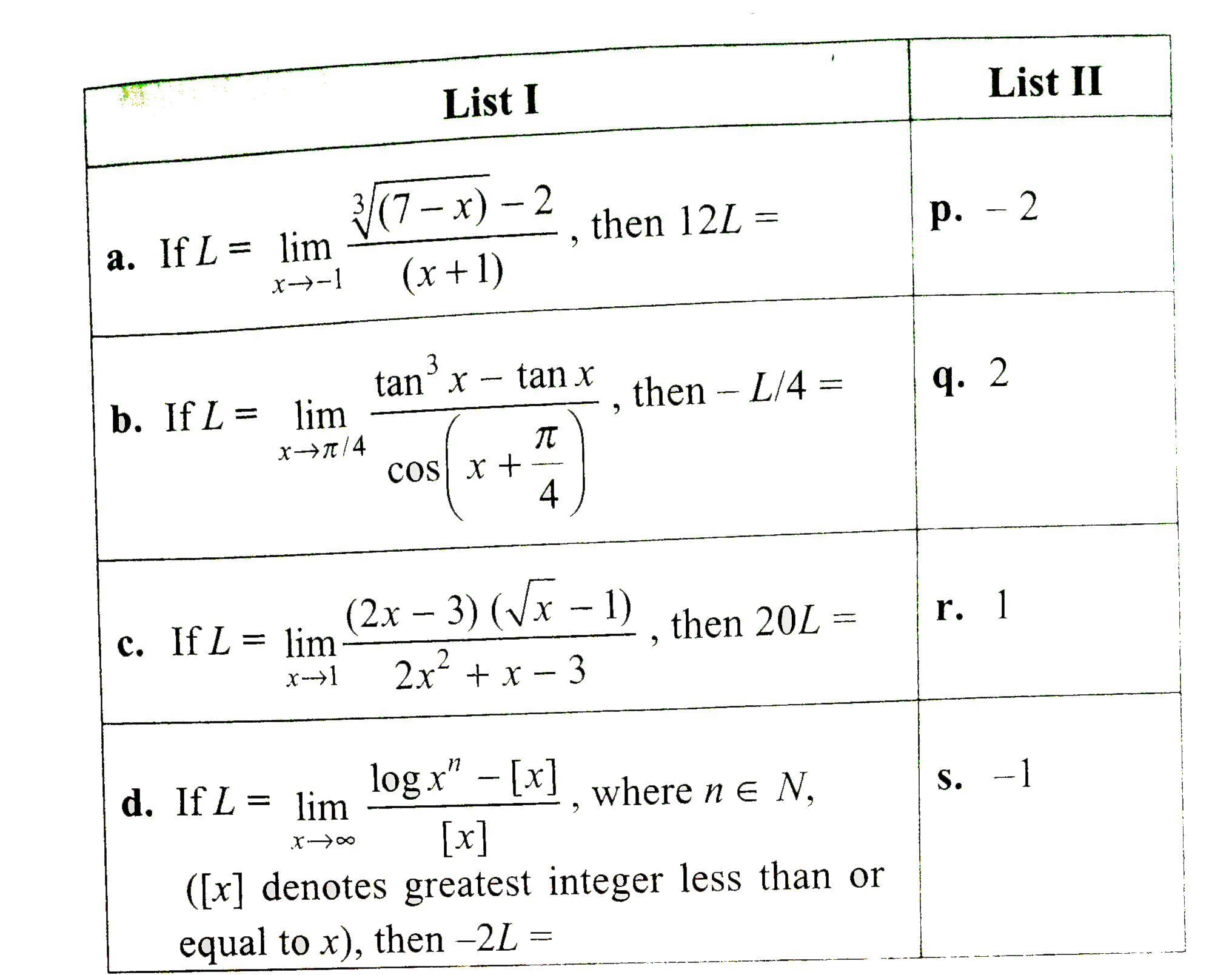Leta1>a2>a3>...>an>1.
p1>p2>p3>...>pn>0 such that p1+p2+p3+...+pn=1.
Also, F(x)=(p1ax1+...pnaxn)1/x.
limx→∞F(x) equals Solution in Bengali
The correct Answer is:D
Letlimx→∞F(x)=L
∴ lnL=limx→∞p1ax1lna1+p2ax2lna2+...+pnaxnlnanp1ax1+p2ax2+...+pnaxn
Dividing by (an)x and taking limx→∞(a1an)x,(a2an)x,etc. vanish.
Therefore,
lnL=pnlnanpn
or L=an
Topper's Solved these Questions
- LIMITSBOOK - CENGAGE PUBLICATIONCHAPTER - LIMITSEXERCISE - Matrix Match Type
5 Videos
- LIMITSBOOK - CENGAGE PUBLICATIONCHAPTER - LIMITSEXERCISE - Numerical Value Type
26 Videos
- LIMITSBOOK - CENGAGE PUBLICATIONCHAPTER - LIMITSEXERCISE - Exercises (Single Correct Answer Type)
76 Videos
- JEE 2019BOOK - CENGAGE PUBLICATIONCHAPTER - JEE 2019EXERCISE - Chapter 10
8 Videos
- LINEAR COMBINATION OF VECTORS, DEPENDENT AND INDEPENDENT VECTORSBOOK - CENGAGE PUBLICATIONCHAPTER - LINEAR COMBINATION OF VECTORS, DEPENDENT AND INDEPENDENT VECTORSEXERCISE - DPP 1.2
10 Videos
Similar Questions
Match the following lists:

View SolutionThe reciprocal of the value of: limn→∞(1−122)(1−132)(1−142)(1−1n2)is
View Solutionlimx→0[sin(sgn(x))(sgn(x))], where [.] denotes the greatest integer function, is equal to
View SolutionIf y = y(x) is the solution of the differential equation, xdydx+2y=x2 satisfying y(1) = 1, then y(12) is equal to
View SolutionThe number of integral values of p for which (p+1)ˆi−3ˆj+pˆk,pˆi+(p+1)ˆj−3ˆk and −3ˆi+pˆj+(p+1)ˆk are linearly dependent vectors is q
View SolutionIf n is a natural number such that n=P_(1)^(a_(1))P_(2)^(a_(2))P_(3)^(a_(3))...P_(k)^(a_(k)) where p_(1),p_(2),...p_(k) are distinct primes then minimum value of ln n is:
View Solutionif (1+x)^(n)=p_(0)+p_(1)x+p_(2)x^(2)+--+p_(n)x^(n) the value of p_(1)-p_(3)+p_(5)+...
View SolutionLet a_(1) p_(2)>...p_(n)>0 such that p_(1)+p_(2)+p_(3)+p_(n)=1. Also F(x)=(p_(1)a_(1)^(x)+p_(2)a_(2)^(x)+...+p_(n)an^(x))^((1)/(z)) Compute
View SolutionIf (1+x)^(n)=p_(0)+p_(1)x+p_(2)x^(2)+....+p_(n)x^(n) then (p_(0)-p_(2)+p_(4)-p_(6)+....)/(p_(1)-p_(3)+p_(5)-p_(7)+......)=
View SolutionLet p_(1),p_(2),...,p_(n) and x be distinct real number such that (sum_(r=1)^(n-1)p_(r)^(2))x^(2)+2(sum_(r=1)^(n-1)p_(r)p_(r+1))x+sum_(r=2)^(n)p_(r)^(2)<=0 then p_(1),p_(2),...,p_(n) are in G.P.and when Statement 2: If (p_(2))/(p_(1))=(p_(3))/(p_(2))=...=(p_(n))/(p_(n-1)), then p_(1),p_(2),...,p_(n) are in G.P.
View SolutionLeta1>a2>a3>...>an>1.
p1>p2>p3>...>pn>0 such that p1+p2+p3+...+pn=1.
Also, F(x)=(p1ax1+pnaxn)1/x.
limx→∞F(x) equals
View SolutionProve that 1+1⋅1P1+2⋅2P2+3⋅3P3+…+n⋅nPn=n+1Pn+1.
View SolutionThese questions are based on the given data.
A polynomial can be represented in an equivalent sequence form.
The polynomial p1xk1+p2xk2+p3xk3+...pnxkn where k1>k2>k3...Gtknanda1≠0 for 1≤i≤n will be represented as the sequence (p1,k1,p2,k2,p3,k3....pn,kn)
Also, we add, subtract, multiply as we do for corresponding polynomials. The resulting polynomial is again represented as sequence.
Which of the following is incorrect?
View SolutionThe value of nP1+nP22!+nP33!+......+nPnn!
View Solution(1+x)n=p0+p1x+p2x2+…+pnxn , then p0+p3+p6+….. =
View SolutionLeta1>a2>a3>...>an>1.
p1>p2>p3>...>pn>0 such that p1+p2+p3+...+pn=1.
Also, F(x)=(p1ax1+pnaxn)1/x.
limx→0+F(x) equals
View Solution